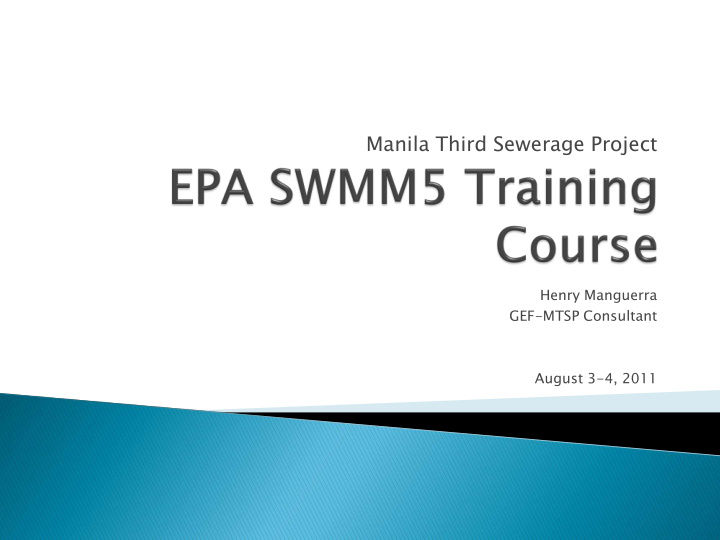



Manila Third Sewerage Project Henry Manguerra GEF-MTSP Consultant August 3-4, 2011
Introduction Watershed/Water Quality Modeling 101 Chesapeake Bay TMDL – A Complex Modeling Example GIS for Modeling EPA SWMM5 Theory and Hands-On Tutorial Hypothetical SWMM Application in San Juan River Watershed Summary and Next Steps Optional Module: MapWindow Hands-On Exercises
Manila Third Sewerage Project Introduction Henry Manguerra GEF-MTSP Consultant August 3-4, 2011
A watershed and water quality model that can be used to evaluate water quality impacts of sewage and sanitation projects in Manila Bay watershed Desired Outcome: Strengthen water quality modeling and assessment capabilities to support the identification of water pollution problems, the estimation of pollution loads, and the setting of priorities and targets for sewage and sanitation projects
Use the model to assist in identifying strategic and effective environmental projects for the restoration and protection of water quality of Manila Bay and its tributaries within the National Capital Region. Factors: Pollution control effectiveness Financial/economic feasibility Social impacts Master Plan Environmental impacts Revision Institutional drivers and Under MTSP capacity Master ter Plan Water Quality Modeling
17 LGUs Caloocan Main Receiving Las Pinas WaterBodies Makati Pasig River Malabon Marikina River Mandaluyong San Juan River Manila NMTT River Marikina Paranaque Muntinlupa Laguna de Bay Navotas Paranaque MWSS Service Pasay Area Pasig MWSI Pateros MWCI Quezon City San Juan Taguig Valenzuela
◦ Selected and approved the EPA SWMM Model for San Juan WQMA ◦ Formed the Modeling Workgroup ◦ EPA SWMM Model Training ◦ EPA SWMM Model Application Workshop
To understand capabilities of the SWMM model and its potential applications for the protection and restoration of Manila Bay watershed To gain operational familiarity of the model through hands-on exercises supplemented by its theoretical underpinnings as needed To become familiar with selected data processing/GIS technologies to support watershed/water quality modeling using SWMM model
Decision makers, and program/project managers involved in the restoration/ protection of the Manila Bay watershed Technical managers/specialists, modelers, data and GIS specialists
Continuous Adaptive Management Process WQ Monitoring Program Monitor water quality NPDES Permitting, WQ Assess against water Implement Plan Compliance Standards quality standards to and Program determine if waterbody Enforcement is Impaired or not and NPS Programs If impaired, determine Plan what S&S Investments allowable maximum and management measures pollutant load and will collectively meet load required load reduction reduction requirement Model Model TMDL Program
Jumpstarting the process Monitor water quality Assess against water Implement Plan quality standards to determine if waterbody is Impaired or not If impaired, determine Plan what S&S Investments allowable maximum and management measures pollutant load and will collectively meet load required load reduction reduction requirement 50 Percent Model Model BOD Load Reduction
Pollutant Loads from Water Quality Impacts at the Bay Watershed the Bay/Lake and Tributaries Management Decisions on Investments and Other Measures To Reduce Pollution Loads and Meet Water Quality Standards Integrated Suite of Models = Watershed Model + Receiving Bay/Lake Model
In-stream processes only • Land and in-stream processes Flow time series user input • Rainfall – runoff process Pollutant sources are represented • Nonpoint and point pollutant as direct discharges to the stream sources
DELTARES DELFT3D • EPA SWMM DHI MIKE11 • EPA HSPF EPA WASP • USDA SWAT • DHI Mike-BASIN • DHI Mike-Urban
WASP (Marikina River) MIKE11 (Pasig River) DELFT3D (Laguna Lake)
Consistent with the paradigm of protecting and restoring waters using the watershed approach Provides the capability to simulate important land- based processes ◦ Rainfall – runoff ◦ Pollutant fate and transport of nonpoint (diffused) sources during wet-weather Provides hydrologic and pollutant load input to receiving water models (including to its internal in- stream module) Serves as a framework for a holistic and watershed- wide assessment of what-if management scenarios including land-based measures Allows better integration with GIS technology ◦ Take advantage of watershed delineation and characterization tools
• Watershed Model (Urban) • Rainfall-Runoff Process • Nonpoint Sources (Watershed) • Point Sources (Direct Discharge) • Steady, Kinematic, Dynamic • Event-Based, Continuous
• The watershed model expands Agency’s modeling capacity and flexibility • use the most appropriate model for the given situation • use an integrated model by linking watershed model with receiving water model
(a) Watershed Model = SWMM (c) Linked Model: Bay/Lake = Boundary conditions Watershed Model = SWMM 2D/3D Receiving Water Model = DELFT3D (d) Linked Model: (b) Linked Model: Watershed Model = SWMM Watershed Model = SWMM 1D River Model = WASP 2D/3D Bay Model = DELFT3D/WASP Bay/Lake = Boundary conditions 2D/3D Bay Model = DELFT3D
• For the purposes of MTSP, configuration (a) is sufficient to evaluate pollutant loads and load reductions associated with S&S investments What S&S investments? Will result to 50% reduction in BOD load • Configurations (b), (c), (d) allow evaluation of water quality impacts in the Bay What is the impact of 50% reduction in BOD load? to the water quality in the bay • Note that configuration (a) also allows the evaluation of water quality impacts in 1-D receiving waters (e.g., Pasig river)
Recommend
More recommend